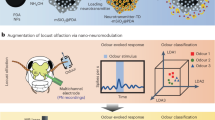Abstract
Olfaction is a very important sensation for all animals. Recently great progress has been made in the research of olfactory transduction. Especially the novel finding of the gene superfamily encoding olfactory receptors has led to rapid advances in olfactory transduction. These advances also promoted the research of biomimetic olfactory-based biosensors and some obvious achievements have been obtained due to their potential commercial prospects and promising industrial applications. This paper briefly introduces the biological basis of olfaction, summarizes the progress of olfactory signal transduction in the olfactory neuron, the olfactory bulb and the olfactory cortex, outlines the latest developments and applications of biomimetic olfactory-based biosensors. Finally, the olfactory biosensor based on light addressable potentiometric sensor (LAPS) is addressed in detail based on our recent work and the research trends of olfactory biosensors in future are discussed.
Similar content being viewed by others
References
Buck L, Axel R. A novel multigene family may encode odorant receptors: A molecular basis for odor recognition. Cell, 1991, 65: 175–187
Dryer L, Berghard A. Odorant receptors: a plethora of G-protein-coupled receptors. Trends Pharmacol Sci, 1999, 20: 413–417
Sullivan S L, Ressler K, Buck L B. Spatial patterning and information coding in the olfactory system. Curr Opin Genet Dev, 1995, 5: 516–523
Mori K, Nagao H, Yoshihara Y. The olfactory bulb: Coding and processing of odor molecule information. Science, 1999, 286: 711–715
Ache B W, Young J M. Olfaction: Diverse species, conserved principles. Neuron, 2005, 48: 417–430
Lewcock J W, Reed R R. Ors rule the roost in the olfactory system. Science, 2003, 302: 2078–2079
Nakamura T. Cellular and molecular constituents of olfactory sensation in vertebrates. Comp Biochem Physiol A: Physiol, 2000, 126: 17–32
Reisert J, Lai J, Yau K W, et al. Mechanism of the excitatory Cl response in mouse olfactory receptor neurons. Neuron, 2005, 45: 553–561
Ressler K J, Sullivan S L, Buck L B. Information coding in the olfactory system: Evidence for a stereotyped and highly organized epitope map in the olfactory bulb. Cell, 1994, 79: 1245–1255
Liedo P M, Gheusi G, Vincent J D. Information processing in the mammalian olfactory system. Physiol Rev, 2005, 85: 281–317
Vosshall L B. Putting smell on the map. Trends Neurosci, 2003, 26: 169–170
Xu F Q. That’s your left foot and.... Trends Neurosci, 2001, 24: 549–550
Carlson J R. Viewing odors in the mushroom body of the fly. Trends Neurosci, 2001, 24: 497–498
Kay L M, Stopfer M. Information processing in the olfactory systems of insects and vertebrates. Semin Cell Dev Biol, 2006, 17: 433–442
Aungst J L, Heyward P M, Puche A C, et al. Centre-surround inhibition among olfactory bulb glomeruli. Nature, 2003, 426: 623–629
Leon M, Johnson B A. Olfactory coding in the mammalian olfactory bulb. Brain Res Rev, 2003, 42: 23–32
Hallem E A, Carlson J R. The odor coding system of Drosophlia. Trend Genet, 2004, 20: 453–459
Zhou Z H, Buck L B. Combinatorial effects of odorant mixes in olfactory cortex. Science, 2006, 311: 1477–1481
Sun A, Yang Y, Jiang Y L, et al. Electro-mass olfactory multi-sensor (emms). Sens Actuators B Chem, 2000, 66: 88–93
Wu T Z. A piezoelectric biosensor as an olfactory receptor for odour detection: electronic nose. Biosens Bioelectron, 1999, 14: 9–18
Ko H J, Park T H. Piezoelectric olfactory biosensor: Ligand specificity and dose-dependence of an olfactory receptor expressed in a heterologous cell system. Biosens Bioelectron, 2005, 20: 1327–1332
Sung J H, Ko H J, Park T H. Piezoelectric biosensor using olfactory receptor protein expressed in Escherichia coli. Biosens Bioelectron, 2006, 21: 1981–1986
Fromherz P, Offenhausser A, Vetter T, et al. Aneuron-silicon junction: A Retzius cell of the leech on an insulated-gate field effect transistor. Science, 1991, 252: 1290–1293
Schütz S, Schoning M J, Schroth P, et al. An insect-based biofet as a bioelectronic nose. Sens Actuators B Chem, 2000, 65: 291–295
Huotari M J. Biosensing by insect olfactory receptor neurons. Sens Actuators B Chem, 2000, 71: 212–222
Ivic L, Zhang C, Zhang X, et al. Intracellur trafficking of a targed and functional mammalian olfactory receptor. J Neurobiol, 2002, 50: 56–68
Rich R L, Myszka D G. Advances in surface plasmon resonance biosensor analysis. Curr Opin Biotechnol, 2000, 11: 54–61
Lee J Y, Ko H J, Park T H. Cell-based measurement of odorant molecules using surface plasmon resonance. Enzyme Microb Technol, 2006, 39: 375–380
Ismail A B, Yoshinobu T, Iwasaki H, et al. Investigation on light-addressable potentiometric sensor as a possible cell-semiconductor hybrid. Biosens Bioelectron, 2003, 18: 1509–1514
Stein B, George M, Gaub H E, et al. Extracellular measurement of averaged ionic currents with the light-addressable potentiometric sensor (LAPS). Sens Actuators B Chem, 2004, 98: 299–304
Xu G X, Ye X S, Qin L F, et al. Cell-based biosensors based on light-addressable potentiometric sensors for single cell monitoring. Biosens Bioelectron, 2005, 20: 1757–1763
Liu Q J, Cai H, Wang P, et al. Olfactory cell-based biosensor: A first step towards a neurochip of bioelectronic nose. Biosens Bioelectron, 2006, 22: 318–322
Wang P. Artificial Olfaction and Taste (in Chinese), Beijing: Science Press, 2000
Li Y, Liu Q J, Xu Y, et al. The development of taste transduction and taste chip technology. Chin Sci Bull, 2005, 50(14): 1425–1433
Wang P, Xu G X, Qin L F, et al. Cell-based biosensors and its application in biomedicine. Sens Actuators B Chem, 2005, 108: 576–584
Author information
Authors and Affiliations
Corresponding author
Additional information
Supported by the National Natural Science Foundation of China (Grant No. 30627002) and the Foundation of Zhejiang Province for Outstanding Talents (Grant No. R205502)
About this article
Cite this article
Wu, C., Wang, L., Zhou, J. et al. The progress of olfactory transduction and biomimetic olfactory-based biosensors. Chin. Sci. Bull. 52, 1886–1896 (2007). https://doi.org/10.1007/s11434-007-0295-9
Received:
Accepted:
Issue Date:
DOI: https://doi.org/10.1007/s11434-007-0295-9




